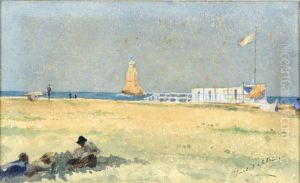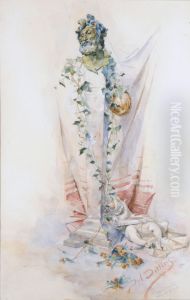Juliaan Dillens Paintings
Juliaan Dillens, also known as Jules Dillens, was a prominent Belgian sculptor born on May 8, 1849, in Antwerp, Belgium. He was part of a well-known family of artists; his father, Hendrik Dillens, was a respected painter, which provided Juliaan with an artistic environment from an early age. His brother, Adolf Dillens, also pursued a career in the arts as a painter. This nurturing atmosphere undoubtedly played a crucial role in shaping his future career in sculpture.
Dillens received his formal education in the arts at the Royal Academy of Fine Arts in Antwerp, where he was trained in the academic tradition. His education there laid the foundation for his future works, which often reflected the classical and romantic styles of sculpture. After completing his studies, Dillens' talent and skill quickly garnered attention in the Belgian art scene.
Throughout his career, Dillens focused on creating sculptures that were not only aesthetically pleasing but also carried a deeper significance, often exploring themes such as history, mythology, and allegory. His works were characterized by their detailed execution and expressive nature, making them resonate with both the public and critics. One of his most famous works is the monument dedicated to Alexandre Gendebien, located in Brussels, which showcases his ability to capture emotion and dynamism in bronze.
Dillens' contributions to Belgian sculpture were significant during his lifetime, and he participated in numerous exhibitions, both nationally and internationally. His works were well received, and he was awarded several honors, reflecting his status as one of the leading sculptors of his era in Belgium.
Juliaan Dillens passed away on December 24, 1904, in Schaerbeek, leaving behind a legacy that continued to influence Belgian sculpture. His dedication to his craft and his ability to imbue his works with depth and emotion have ensured that his sculptures remain admired and studied by art historians and enthusiasts alike. Dillens' life and work remain a testament to the richness of Belgian art in the 19th century and its capacity to speak to universal human experiences.


